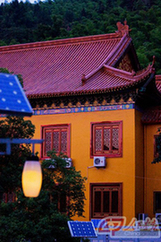Get thee to a nunnery
|
|
|
Master Miaole, the abbess of the Tiefo Temple. [Photo by Ma Gengping] |
Known as the largest nunnery in southern China's Jiangxi Province, Tiefo Temple sits at the northwest foot of Lushan Mountain, and is home to more than 50 nuns studying and practicing Buddhism.
It was time for breakfast when the chanting ended, a busy time for Master Yanyin as she is responsible for the catering affairs of the temple. She mentions that the nuns always eat their meals together in the dining area in the lower right of the Nianfo Hall. The center of this space is dominated by a statue of Avalokitesvara, the Goddess of Mercy, with a dozen rows of rectangular tables, allowing more than 100 people to be seated at the same time, surrounding her. Diners are required to behave in accordance with strict rules, and chatting is forbidden while eating. Naturally, dishes are all vegetarian and made from the simplest ingredients. A plaque on the wall carries an inscription: "Visitors may dislike our insipid food but Buddhist shrines are not as colorful as the secular world."
![Holding a water container in her hands, a nun prays for the hope that the water will nourish all walks of life. [Photo by Ma Gengping] Holding a water container in her hands, a nun prays for the hope that the water will nourish all walks of life. [Photo by Ma Gengping]](http://images.china.cn/attachement/jpg/site1007/20091027/00114320ca550c50ae633e.jpg) |
|
Holding a water container in her hands, a nun prays for the hope that the water will nourish all walks of life. [Photo by Ma Gengping] |
The afternoon chanting session begins at 3:30 p.m., and also takes place in the Nianfo Hall. The nuns, dressed in puce robes, line up in two files and walk slowly into the chamber, where three statues greet them. In the center is the Buddha Amitabha, his left hand placed in front of his chest carrying a lotus throne, and his right hand pointing downwards, a posture symbolizing his role of instructing human beings. The left statue is Avalokitesvara, her left hand carrying a bottle and her right hand carrying a willow branch, symbolizing her salvation of all living creatures. The right statue is Mahasthamaprapta, who carries in her left hand a lotus stem and in her right a seed pod.
A chime sounds, and the nuns stand on the two sides of the statues, their palms placed together, and begin to chant the sutras. Sometimes they bow to the statues in reverence, and sometimes they kneel before them. Walking around the Buddha is another crucial part of the afternoon ritual. The nuns circle while chanting "Amitabha" to pray for peace and public well-being. Imbued with the tapping on the wooden fish (a percussion instrument made of a hollow wooden block) and the sweet fragrance of incense sticks, the hall seems both majestic and solemn.
|
|
|
Walking around the Buddha, the nuns circle while chanting "Amitabha" to pray for peace and public well-being. [Photo by Ma Gengping] |
Tiefo Temple now covers more than 13 hectares, with the buildings themselves totaling 10,000 square meters. It is hard to believe that this magnificent establishment was reconstructed by Master Miaole, the nunnery's current abbess, from near ruin only two decades ago.
Historical records reveal that the temple was first built during the Zhenguan reign of the Tang Dynasty (618-907). At that time, the temple had more than 600 statues, including a two-meter-tall Buddha made of iron, hence its name Tiefo --- "tie" means "iron" and "fo" means "Buddha". It was originally dominated by males. Early in the Song Dynasty (960-1276), Master Yuanlian set about recruiting many female disciples, converting the temple into a nunnery. Over the course of its history, Tiefo Temple has witnessed many ups and downs, particularly during the chaos of the Cultural Revolution when the temple was almost torn to the ground, and only a shabby bungalow remained amidst barren rocks.
In April 1989, Master Miaole visited the temple, which was on the verge of collapse. At the south end of the nearby White Dragon Bridge, she came across the poem inscribed by Master Yuanlian, and inspired, decided there and then to reconstruct the ancient temple. In August of the same year, with the agreement of the municipal government of Jiujiang, Master Miaole began her painstaking efforts to reconstruct the Tiefo Temple. It was difficult work, in an area riddled with thorns and weeds, and initially, without any power supply or roads for easy access. To raise the necessary funds, Master Miaole sold her own personal assets and borrowed more than 100,000 yuan, buying a light truck with which to transport building materials. Then to save money, she and several followers fed themselves with only steamed bread and lived out of tents. Though conditions were tough, Master Miaole never gave up her duties as teacher and guide to her pupils. Moved by her selfless spirit, many donated money for the reconstruction process and within four years, the temple was revived and gradually became known far and wide.
![The nuns leave the Nianfo Hall after completion of afternoon chants. [Photo by Ma Gengping] The nuns leave the Nianfo Hall after completion of afternoon chants. [Photo by Ma Gengping]](http://images.china.cn/attachement/jpg/site1007/20091027/00114320ca550c50af5540.jpg) |
|
The nuns leave the Nianfo Hall after completion of afternoon chants. [Photo by Ma Gengping] |
|
|
|
At dusk, the street lamps light up the tranquil temple. [Photo by Ma Gengping] |
Visitors to this wonderful complex can not only enjoy picturesque natural landscapes, but also learn the legendary history of the Tiefo Temple and enjoy the inner peace brought by Buddhist culture.
Travel Tips:
The Tiefo Temple lies at the northwest foot of Lushan Mountain, 14 kilometers away from downtown Jiujiang, Jiangxi Province. Visitors can get there by taxi or tour bus. Vegetarian food offered by the temple's Shangzhai Hall is a local treat, especially its vegetarian fish made from bean curd. A well-furnished hotel is also available to visitors who want to stay overnight.
 0
0 



![Master Miaole, the abbess of the Tiefo Temple. [Photo by Ma Gengping] Master Miaole, the abbess of the Tiefo Temple. [Photo by Ma Gengping]](http://images.china.cn/attachement/jpg/site1007/20091027/00114320ca550c50adcd3d.jpg)
![Walking around the Buddha, the nuns circle while chanting 'Amitabha' to pray for peace and public well-being. [Photo by Ma Gengping] Walking around the Buddha, the nuns circle while chanting 'Amitabha' to pray for peace and public well-being. [Photo by Ma Gengping]](http://images.china.cn/attachement/jpg/site1007/20091027/00114320ca550c50aee33f.jpg)





